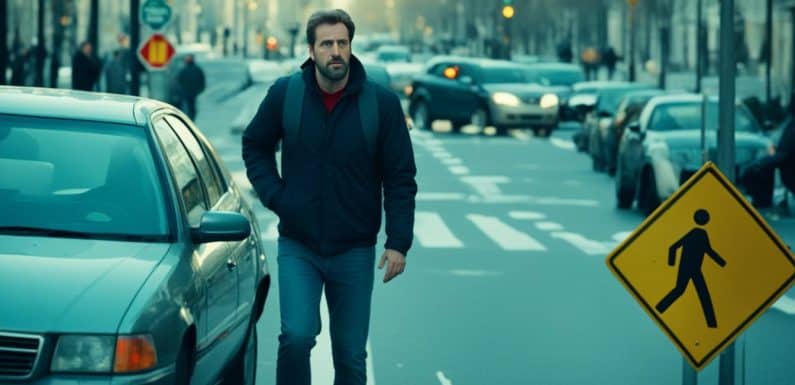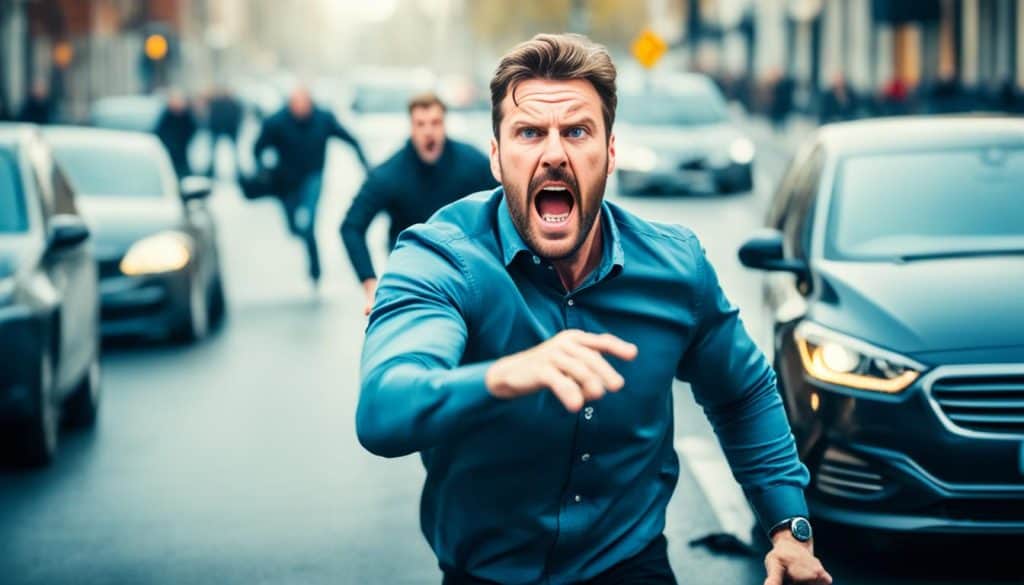
When a pedestrian walks out into the street in violation of the law, drivers should adhere to strict safety protocols to prevent accidents and uphold safety. While it may be the pedestrian’s mistake, the onus is still on the driver to react responsibly. This means being vigilant, slowing down, and preparing to stop if necessary to ensure the well-being of the pedestrian, themselves, and other road users.
Understanding your legal responsibilities and the safety protocols for drivers can significantly lower the risks associated with pedestrians’ unlawful street crossing. This article will provide you with insights into navigating these complex situations legally, ethically, and safely. Keep reading to become more adept at handling unexpected pedestrian movements on the road and protecting all parties involved.
Key Takeaways
- Always remain alert and ready to respond to pedestrians’ illegal road crossings.
- Understanding your legal responsibilities as a driver can help prevent accidents.
- Familiarize yourself with pedestrian rights and warnings within your state.
- Know the penalties associated with failure to yield and traffic infringements involving pedestrians.
- Implement safety protocols for drivers to safeguard against roadside incidents.
- Maintain a focus on defensive driving to navigate unexpected situations effectively.
Legal Responsibilities of Motorists When Pedestrians Violate Laws
Motorists bear significant legal responsibilities when it comes to interactions with pedestrians, even more so in incidents where pedestrians may violate traffic laws. Understanding statutory obligations, alongside the right-of-way protocols, helps in promoting road safety and averting potential accidents. This exploration into the intricate relationship between drivers and pedestrians underscores the essential principles every motorist should be conversant with.
Pedestrian Rights and Warnings in Different States
In the United States, pedestrian rights can vary significantly from state to state. Each jurisdiction outlines specific regulations to ensure pedestrian safety, often including marked crossings, signals, and signs that guide their movements. Motorists must remain aware of local laws to respect these rights and respond to contextual warnings. Not adhering to state-specific protocols can result in breaches of legal duties, rendering drivers susceptible to liability.
Interpreting Right-of-Way Protocols to Prevent Harm
Navigating right-of-way protocols requires a nuanced understanding of both vehicular and pedestrian movement patterns. Drivers should be cognizant of scenarios where pedestrians are granted the right-of-way by law, such as at crosswalks with the walk signal illuminated. However, when pedestrians act in contravention of these protocols, motorists still have a duty to act reasonably and prevent harm whenever possible. Vigilance and readiness to act are paramount in these situations.
Penalties for Failure to Yield and Related Traffic Infractions
The penalties for failure to yield can be substantial, reflecting the seriousness of the offense and its potential to result in pedestrian harm. Punishments range from fines and points on a driver’s license to more severe consequences such as suspension or revocation of driving privileges. These penalties serve as a deterrent, enforcing the critical need for drivers to observe legal standards for right-of-way and prioritize pedestrian safety.
| State | Right-of-Way Law | Penalties for Noncompliance |
|---|---|---|
| California | Yield to pedestrians at crosswalks and unmarked intersections. | Fines up to $250 and points on driving record. |
| New York | Pedestrians have the right-of-way at all crosswalks, marked and unmarked. | Fines ranging from $50 to $300, potential imprisonment, and points on driving record. |
| Texas | Drivers must yield when pedestrians are in their half of the roadway. | Fines from $50 to $200, higher if a pedestrian is injured. |
| Florida | Motorists must yield at crosswalks when traffic control signals are not in place or not in operation. | Fines of $65, higher penalties including community service, for violations that lead to a pedestrian injury. |
When a Pedestrian Walks Out into the Street in Violation of the Law, You Should

Dealing with a pedestrian violation of the law requires both patience and vigilance from drivers. When a pedestrian unexpectedly enters the roadway, it’s crucial to manage your driver response carefully to ensure everyone’s safety. Here are steps to take:
- Immediately reduce your speed. Even if a pedestrian is at fault, as a driver, safety comes first.
- Prepare to stop if necessary. Always assume that the pedestrian does not see your vehicle.
- Use your horn delicately to alert the pedestrian, but avoid aggressive or prolonged honking, as it may startle or confuse them.
- Look around for other pedestrians and vehicles that may react to the situation.
- Once the pedestrian is out of harm’s way, proceed with caution, continually scanning the road for potential jaywalkers.
It’s not uncommon for drivers to encounter situations where a pedestrian steps into the street in contradiction of the law. Having a predefined driver response plan can prevent accidents and ensure that the reaction is both legal and considerate. By staying alert and prioritizing safety, drivers can navigate these incidences successfully, even if the pedestrian’s actions are unexpected.
Practical Safety Measures for Avoiding Pedestrian Accidents
Every motorist bears the responsibility to operate their vehicle with caution, especially when it comes to ensuring pedestrian safety. As pedestrian accidents can have catastrophic outcomes, it is important to prioritize practical safety measures at all times. This section highlights key strategies that drivers should adopt to avoid such unfortunate incidents.
Utilizing Defensive Driving Techniques
Defensive driving is a term that encompasses a wide range of skills, but at its core, it involves being vigilant and ready to react to the unexpected. Defensive driving techniques include maintaining a safe following distance, regularly checking mirrors, and being particularly careful in pedestrian-heavy areas. When drivers anticipate potential hazards before they occur, they are more likely to prevent accidents.

Assessing Situations and Reacting Decisively
The ability to quickly assess situations is crucial in preventing accidents. This can range from recognizing a pedestrian’s intention to cross the street to identifying a distracted walker. Quick assessment followed by decisive action can mean the difference between a close call and a call to emergency services. Drivers are advised to be aware of their surroundings and be prepared to stop or maneuver in a way that ensures everyone’s safety.
Effective Communication with Errant Pedestrians
Sometimes, effective communication might be all that’s needed to prevent a pedestrian accident. Using your vehicle’s horn to alert someone unknowingly walking into traffic or a simple gesture to yield can significantly reduce the chance of a mishap. Furthermore, your communication should be clear and prompt, aiming to grab the pedestrian’s attention and convey a message of caution.
By incorporating these safety measures into daily driving practices, motorists contribute to a safer environment for pedestrians and drivers alike. Understanding and implementing defensive driving techniques, assessing situations appropriately, and maintaining effective communication are not just recommended strategies—they are essential components of responsible driving.
Aftermath of Pedestrian Encounters: Steps for Drivers to Take
In the immediate aftermath of pedestrian encounters, swift and empathetic action is paramount for all parties involved. Firstly, a driver’s concern should focus on the immediate safety and well-being of the individual. This may involve calling emergency services to ensure that anyone who may have been injured receives prompt medical attention. Even in instances without apparent injuries, it’s crucial for drivers to remain on scene, as leaving prematurely can carry legal ramifications. Notably, when accidents occur, reporting them to the appropriate authorities — such as local law enforcement or traffic divisions — is a mandatory step for drivers to take.
In alignment with the steps for drivers after pedestrian encounters, gathering and documenting key information is essential. This process includes exchanging contact and insurance details with all involved parties. Additionally, drivers are advised to take photographs of the scene from various angles, ensuring that they capture the overall context and any specific damage or environmental factors that could be relevant. If there are witnesses, obtaining their accounts and contact information can be instrumental for any ensuing legal or insurance proceedings. It’s a diligent practice to compile a comprehensive dossier on the incident as part of the aftermath of pedestrian encounters.
Lastly, the importance of seeking medical evaluation should not be underrated. Even if injuries are not immediate or visible, symptoms can manifest later, necessitating thorough medical records for insurance purposes. Likewise, promptly reporting the incident to one’s insurance company can help mitigate potential complexities that may arise during claims processes. In managing the aftermath of pedestrian encounters, such due diligence can safeguard a driver’s position and underpin a defensible narrative, should it become necessary in dealing with legal or insurance outcomes.
